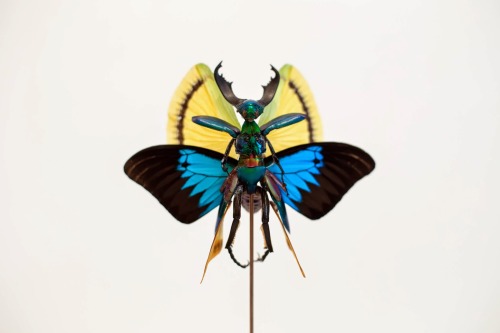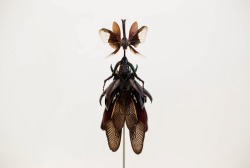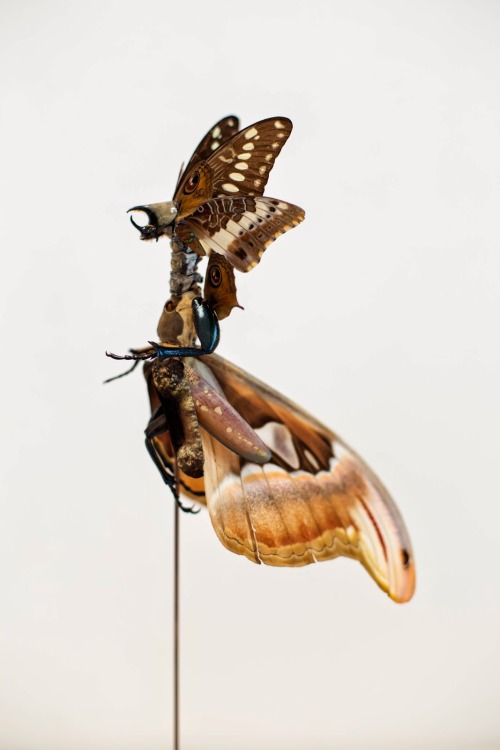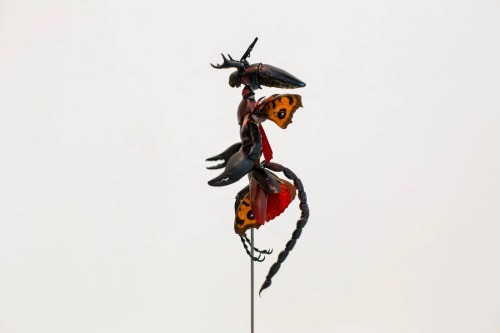"Neukom Vivarium," 2006
Mixed-media installation, greenhouse structure: 80 feet long. Installation view: Olympic Sculpture Park, Seattle
ART21: Tell us something about the backstory of the tree used in your installation, Neukom Vivarium.
DION: On the evening of February 8, 1996, a massive hemlock tree fell over a ravine in a small area of old growth about forty-five miles outside Seattle, in a protected watershed area. Therefore, it didn’t touch the ground and rot away as quickly as it would have.
ART21: How did you choose this particular tree?
DION: We did a great deal of searching and were relieved to find a tree that not only had a lot of personality but that was big and reasonably accessible. We were really interested in getting either a Douglas fir or a Western Hemlock. The Douglas fir has a kind of mythic presence here. The Western Hemlock is also an incredibly charismatic, wonderful tree—and it’s the state tree. So, those were the two species we were most interested in. This one had just fallen into our lap. It’s under the stewardship of a very enlightened watershed program. So, we just found the right tree at the right place.
ART21: What does it mean to take a tree from its natural setting and place it in a gallery context?
DION: I think that one of the important things about this work is that it’s really not an intensely positive, back-to-nature kind of experience. In some ways, this project is an abomination. We’re taking a tree that is an ecosystem—a dead tree, but a living system—and we are re-contextualizing it and taking it to another site. We’re putting it in a sort of Sleeping Beauty coffin, a greenhouse we’re building around it. And we’re pumping it up with a life support system—an incredibly complex system of air, humidity, water, and soil enhancement—to keep it going. All those things are substituting what nature does, emphasizing how, once that’s gone, it’s incredibly difficult, expensive, and technological to approximate that system—to take this tree and to build the next generation of forests on it. So, this piece is in some way perverse. It shows that, despite all of our technology and money, when we destroy a natural system, it’s virtually impossible to get it back. In a sense, we’re building a failure.
ART21: It’s interesting that you’d want to put your efforts into a failure.
DION: I’m very committed to an idea of art making that is based on an experimental model. So, this is an experiment—and experiments fail and succeed. They prove and disprove things. There are a lot of variables and we cannot predict everything. And we’re going to have an amazingly furtive learning experience.
I’m interested in thinking about nature as a process. So, this isn’t really about the tree, even though the tree is the superstar. It’s really about what’s happening to the tree, about the process of decay. We shouldn’t really feel particularly bound up in the demise of this tree because on this tree is the basis of the next forest. The tree supports a living bio-system, from single-cell organisms all the way up to vertebrates—mice, shrews, and birds. I want this piece to talk to the audience but not necessarily spoon-feed them or give them what they want. I want to acknowledge or even enhance the uncanniness of nature—the wonder of the vast complexity and diversity within a natural system.
ART21: Can you say more about what you mean by not necessarily giving your audience what they want?
DION: My job as an artist isn’t to satisfy the public. That’s not what I do. I don’t necessarily make people happy. I think the job of an artist is to go against the grain of dominant culture, to challenge perception, prejudice, and convention. A big flaw in some public art schemes is that they seem to be about trying to find an artist who’s going to please everyone. That’s not interesting to me. I think it’s really important that artists have an agitational function in culture. No one else seems to.
ART21: How does Neukom Vivarium politically engage your audience?
DION: I’m not sure there is a really succinct way to talk about how this piece politically engages people. In a sense, what I’m doing is bringing a forgotten element of the environment back into the city. I’m taking something that would have existed on that site a long time ago and returning it to that site. But, at the same time, I’m building a cultural framework around it.
One of the things that’s difficult about this piece is that it’s hard to locate where the work is. It’s not the tree, and it’s not the building, and it’s not the details like the tiles or the field guide. But it’s really the entire thing. Of course, people tend to focus on the tree, as though the other thing was just a frame, but it’s really an integrated work. It’s not a piece of architecture; it’s a work of art. It’s a total artwork.
ART21: Was there any particular artistic inspiration for this work?
DION: I feel very much connected to the Hudson River School painters and other people of that tradition. That school of painting evolved into the modern school of abstract painters—from Cape Cod right through to earthworks and people like Robert Smithson. I see that as an unbroken chain. Our relationship to the landscape is a strong element in the history of American art because it is remarkably distinct from the European perspective of landscape.
We have always had a notion of wilderness. Of course, that notion has changed dramatically over time. The Hudson River School dealt with it not only in a political way but also in a theological sense. The Hudson River School painters were mostly incredibly religious men who saw this as a kind of expression of their faith. I’m a secular person; I’m not a person of faith. At the same time, I see that my cosmology is really based on science. So, this work has a dialogue with science, as most of my work does. And I think that was true for the Hudson River people as well. Their engagement with travel, their relationship to spectacle and scale—all of those things are built into the way that a number of contemporary artists work with these kinds of issues, myself included. Though for us, it comes through the filter of earth art as well. Earth art added the ingredient of contemporary environmental science. The earth artists weren’t necessarily very environmentally oriented and certainly not very conservation oriented. Some of the stuff that I’m doing really involves a political discourse added onto the conceptual elements that the earth artists were interested in.
ART21: What are some of these conceptual elements?
DION: I think that we’re really talking about systems, and it’s interesting the way that people involved in conceptual art practices were always engaged in systems, whether they were exchange systems or natural systems. An artist like Hans Haacke started off working with natural systems and then applied that to the social realm.
This work engages with a lot of systems that are natural. We’re putting this tree into something like a showroom, a classroom, a laboratory. It makes reference to greenhouses and the history of greenhouses. It’s an incredibly interesting hybrid space. But at the same time, it’s very inclusive. People are allowed to go in. They’re allowed to spend time with it. It’s a space that has a very fantastical element, too, with an almost Bernini-like forced perspective. If you don’t feel a little bit like you’re Alice falling through the rabbit hole when you walk through the door, then we’ve made a mistake.
In some way, I want to acknowledge or even enhance the uncanniness of nature and the wonder of the vast complexity and diversity within a natural system. I want to show how difficult it is for us to grasp, not just conceptually but also practically. How difficult it is for us to figure in all of the variables that you would need to replicate a forest. We’re trying, but we can never do it perfectly. That’s one of the most interesting aspects of the piece for me.
ART21: It’s almost like seeing a tree hooked up to a life support system.
DION: As I said, this is not exactly a feel-good work of art. You should look at this and get the impression of someone in the hospital under an oxygen tent. There should be pangs of melancholy when you see this. Of course, it is in some ways a celebration, but at the same time, it’s full of mourning and melancholy. This tree is something fantastic that has been ripped out of its context. So, there is something monstrous and violent about the very nature of this work. Like, in a natural history museum, you find this feeling of awe toward the skill of the reproduction and, at the same time, a feeling of terror at the tragedy of people killing animals and reproducing them for an urban audience. That’s very much the kind of logic that I’m playing with here.
ART21: The work also functions as a memento mori.
DION: It is a memento mori—an appreciation of decay as a process and as a tool for discourse.
From here.





































